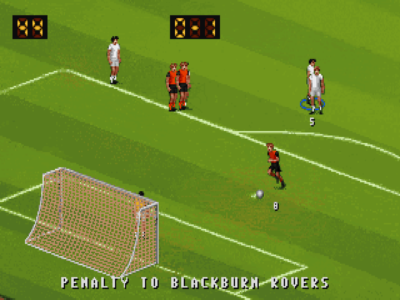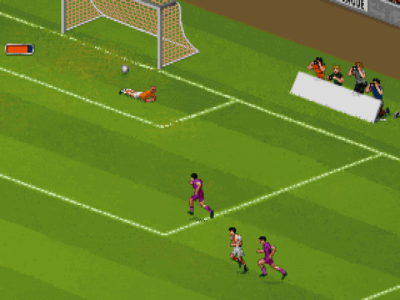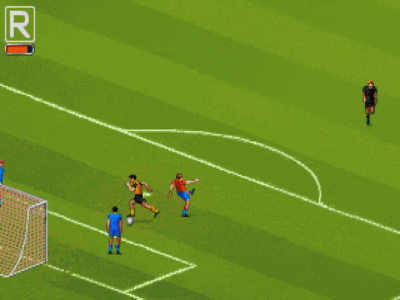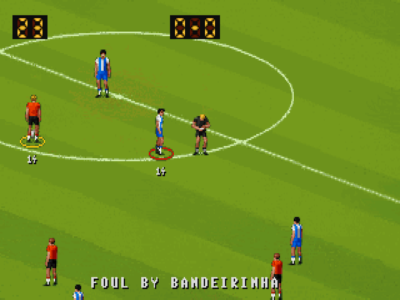
UEFA Champions League
Written by: Rik
Date posted: December 2, 2017
- Genre: Sport
- Developed by: Krisalis Software
- Published by: Philips Interactive Media
- Year released: 1995
- Our score: 1
In a world in which UK football fans not only have to pay to see the best live football on TV, they also have to pay to see the not-so-good and frankly terrible, it seems odd that, for so many years, midweek games from the UEFA Champions League – considered the pinnacle of European football – were broadcast live and for free on ITV, the worst television channel in the world.
But, it did happen. As, apparently, did this game, the first official Champions League tie-in, and a singularly dreadful effort, despite being a follow-up of sorts to Manchester United: The Double, which earned the much-coveted FFG accolade of being ‘not bad’ in the very recent past. Although the Champions League was a different beast back then, it’s hard to imagine UEFA willingly associating itself with a game of such low production values and quality. Adrian Chiles, Andy Townsend, Clive Tyldesley: come back, all is forgiven.
For all that the modern-day release cycle of one FIFA and PES game per year may seem a bit money-oriented, it was arguably more cynical in the old days, when international and European competition was deemed exotic enough to warrant a separate full-price release. Electronic Arts were central to this kind of piss-taking, going for a new game every six months or so, with breaks between FIFA games filled by tournament tie-ins or the likes of FA Premier League STARS, a game based on the Premier League, even though that was already part of the standard FIFA package, justified on the basis of some slightly nicer-looking kits, more authentic stadia, and a wafer-thin RPG levelling system (the STARS of the title).
EA also, briefly, held the license for the Champions League, and instead of making it a selling point of their (at the time) below-par FIFA games, decided to release stand-alone titles which were received as moderately as their other efforts around this time. Before that, Champions League games had been developed by Silicon Dreams, responsible for the short-lived World League Soccer series, and were briefly considered as worthy 3rd/4th place contenders behind the big two of FIFA and PES – the kind of games that might scrape into the Champions League itself.
Back to this one, though, and anyone familiar with the previous couple of Manchester United themed Krisalis efforts will recognise this as a continuation, of sorts, of that series. The menus are presented in the same way, while the ‘Tacti-Grid’ formation editor also remains in place. In-game, the approach seems to have been to combine the isometric perspective and responsive play of The Double with the larger and more impressive player and stadium graphics of Manchester United Europe. Which sounds fair enough in theory, but a little too much emphasis seems to have been placed on replicating the look of Europe, and the visuals really do seem to be straight from a long-forgotten 16-bit title from the late-80s (possibly with a generic title like ‘International Soccer’).
Players’ kits are a little on the tight side, goalkeepers don’t seem to wear gloves, the ball is a featureless plain white effort, and the sight of the subs huddled together on the sidelines calls to mind a lower-league encounter from 1985, a far cry from the supposed glitz and glamour of Europe’s premier competition. The graphics do superficially represent an improvement on The Double, but up close, the animation is found to be lacking. While the players in The Double were tiny and without much detail, at least when they let a shot fly, their little leg was shown to have smashed through the ball with some force. Here, there’s no evidence of the player kicking the ball, other than the ball itself moving. Elsewhere, things that unintentionally raise a smirk are the exceptionally camp goal celebrations and the sight of the referee seemingly rummaging around in the front of his shorts before producing red and yellow cards.
Most importantly, the larger sprites and the zoomed-in view don’t serve the game well. The camera is too close to the action, and can’t keep up with it. The football is chaotic and fast-paced, with little subtlety, despite the addition of another button to the control scheme which suggests that passing might be of more importance this time around. Not so: passing is a sure-fire method of losing the ball, and, given that tackling is nigh-on impossible and dribbling around and around in circles with the ball stuck to your foot is a perfectly effective strategy, it’s best avoided altogether, no matter how committed you might be to playing a cultured European passing game.
If creating chances and scoring goals relied on playing coherent, flowing football, then you’d be totally screwed, but fortunately, a combination of overpowered shooting and extremely thick goalkeepers allows you to punt the ball in from just over the halfway line with consummate ease. If it wasn’t for some unnaturally narrow goals and the solid midriffs of opposition defenders, easy (and heavy) victories could be achieved more readily. As it is, the AI is much more adept at passing the ball, creating chances and generally being better than you. Much like in The Double, they can do things that no human player could achieve, and delight in confusing your ‘keeper with looping high balls into the box. After that, you don’t feel so bad about scoring five goals with the same player straight from the kick off.
A more creative approach against weaker opposition is sometimes possible, and though nothing other than a straight shot is usually required to beat the keeper, there is a level of satisfaction to be gleaned from making an attempt from an unusual angle, or applying a touch of curl. Any slight error in timing, however, and your attempt at goal will instead be punted at a right-angle from the direction intended into the face of an unwitting spectator sat somewhere near the halfway line.
Even with the matches set on two-minute halves, you’re guaranteed a festival of guileless football and goals, goals, goals, all of it a far cry from the cultured technical superiority of the real-life tournament. There’s no compensation for this shortfall in authenticity with the off-field presentation, and use of the license is limited to an introductory video and one that precedes the final.
A significant caveat is that the version tested here isn’t, er, exactly the boxed edition that I bought for several hundred pounds from eBay, so perhaps the one more readily available has had some multimedia elements excised from it. I’m also willing to accept that sundry other technical issues, such as frequent and unexplained crashing, and the inability to make in-game substitutions, might not have been present in the official boxed release. (If, indeed, there ever was one: I’m not actually able to find much evidence of this game ever existing).
As previously mentioned, the Champions League was a different beast at this point in the 90s: only the actual, er, champions qualified, and so the selection of available teams is rather limited. This was one of the few times when Manchester United *didn’t* win the league in that decade, so English fans have to throw their weight behind Blackburn Rovers, whose one memorable real-life contribution to the tournament was when team-mates Graeme Le Saux and David Batty decided to have a punch-up during the opening minutes of an away defeat to Spartak Moscow. Aside from the Champions League itself, you can create custom cup and league tournaments, but only using the teams who were actually in the Champions League.
So, then, UEFA Champions League is an interesting footnote in the history of footy games for those of us interested in such things, and there’s mild comedy value in some of its idiosyncrasies, but the game itself is muck, and a significant fall from the rather decent The Double only a year previously. In the league table of football games covered on FFG, qualification for the Champions League is out of the question: this is firmly rooted to the bottom of the table.






 Posts
Posts